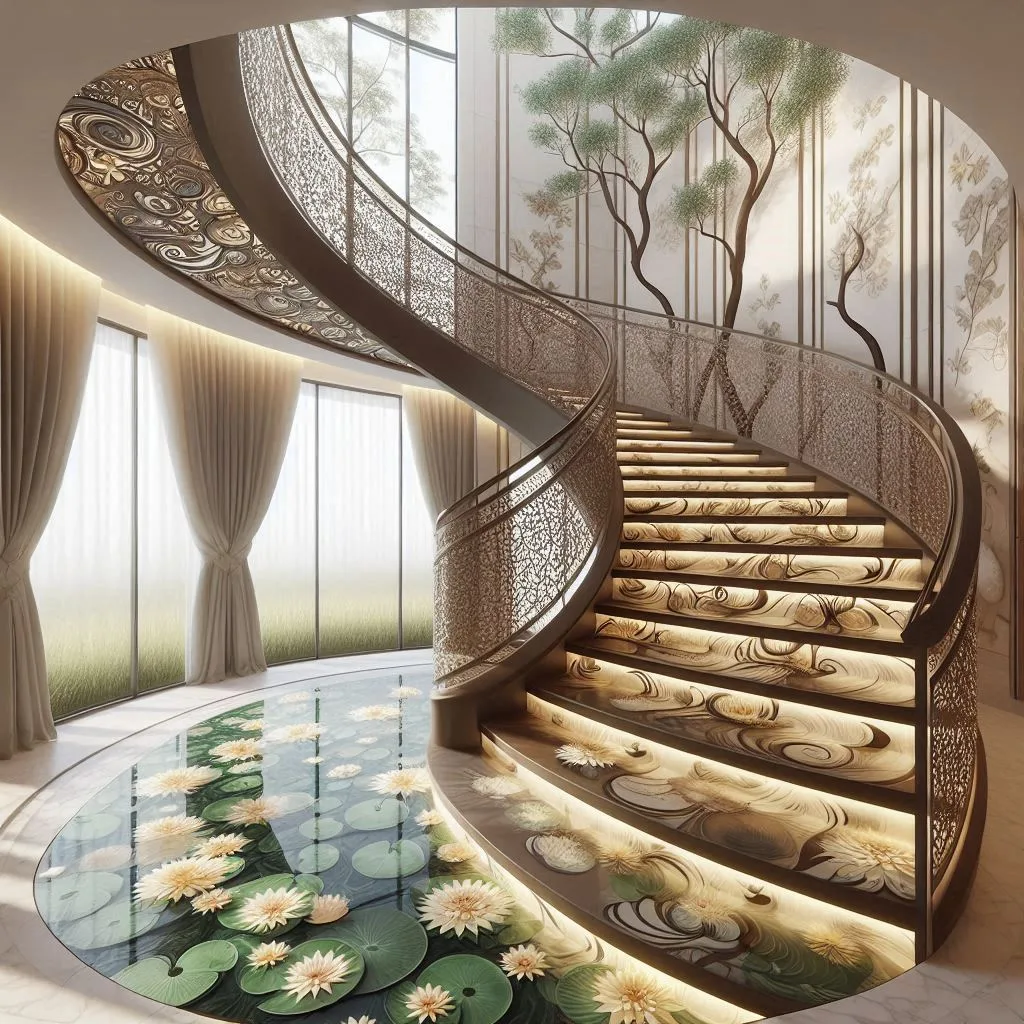Staircases are an essential part of any multi-level home, but they don’t have to be plain or uninspired. A growing trend in modern home design is the nature staircase, which incorporates elements of the natural world into the design of stairways. From rustic wooden steps to living plants and natural stone accents, a nature staircase is a great way to bring the outside in and add an organic feel to your home. This blog post will explore the different ways you can incorporate natural elements into your staircase and why the nature staircase design is gaining popularity in home interiors.
What is a Nature Staircase?
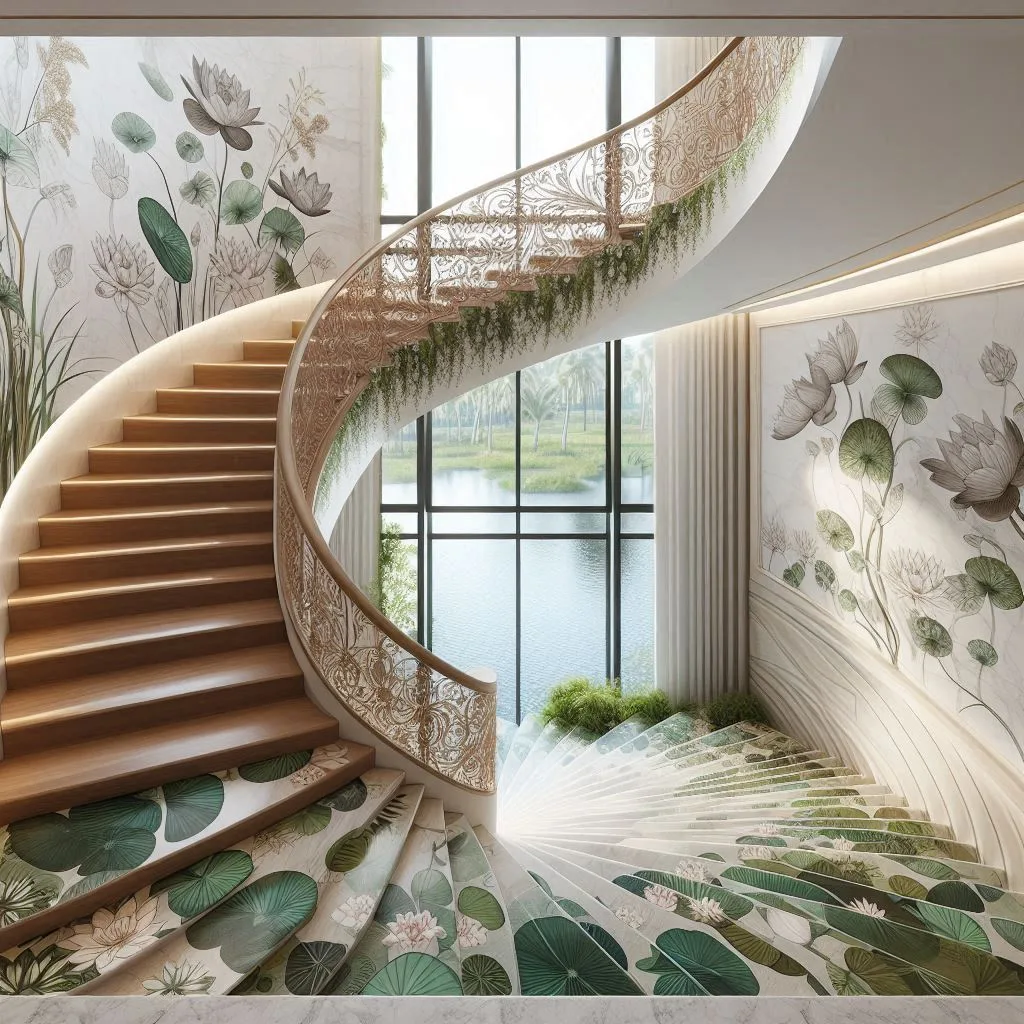
A nature staircase blends the beauty of nature with functional design. It can involve the use of natural materials such as wood, stone, metal, and glass, and often integrates plant life, earthy colors, and textures to create a harmonious, organic look. The idea is to evoke a sense of calm, freshness, and tranquility—much like a walk in the woods.
The Appeal of Nature-Inspired Design
Incorporating natural elements into your home is more than just a design trend; it’s a reflection of our collective desire to reconnect with nature. People are increasingly seeking ways to bring the outdoors into their living spaces as a way to enhance mental well-being, create a serene atmosphere, and add a touch of elegance. Staircases, as one of the most prominent architectural features in a home, offer a perfect canvas for showcasing nature-inspired materials and design.
Types of Nature Staircases
A nature staircase can be as unique and varied as your personal style. There are several ways to incorporate nature-inspired elements into your stairs, from raw, rustic wood to polished stone. Here are some of the most popular types of nature staircases:
Wooden Staircases: The Heart of Nature
Wooden stairs are perhaps the most straightforward way to introduce a nature staircase into your home. The natural grains, textures, and colors of wood make it a timeless material that blends well with almost any design style. Whether you prefer light, pale woods like oak and maple, or rich, dark tones such as walnut and mahogany, wood can bring warmth and elegance to your stairway.
Benefits of Wooden Staircases:
- Durability: With proper maintenance, wooden stairs can last for generations.
- Versatility: Wood complements both modern and rustic designs.
- Sustainability: Opting for reclaimed or sustainably sourced wood helps minimize environmental impact.
Stone Staircases: Solid and Timeless
For those who want to bring a touch of natural elegance and texture to their home, stone staircases are an excellent choice. Materials like granite, limestone, and slate can transform your staircase into a luxurious, earthy feature. The cool, smooth surfaces of stone contrast beautifully with the organic textures of wood and plants.
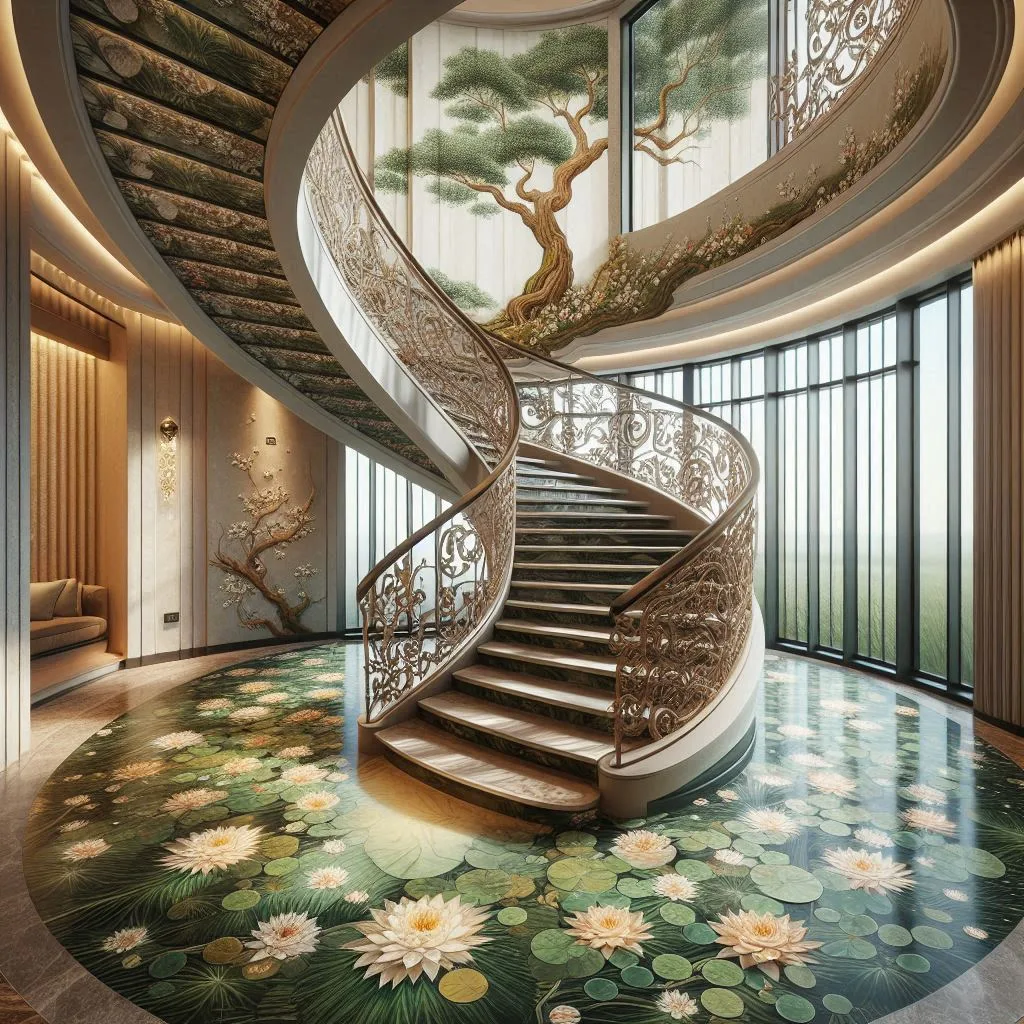
Benefits of Stone Staircases:
- Timeless Appeal: Stone exudes a classic, ageless elegance.
- Strength: Stone is incredibly durable and resistant to wear and tear.
- Low Maintenance: Stone staircases are easy to clean and require little upkeep.
Glass and Steel Staircases: Modern Nature
While wood and stone may evoke a more traditional connection to nature, modern nature staircases may incorporate glass and steel to create a sleek, minimalist look that still captures the essence of nature. Glass railings allow natural light to flood the space, creating an open, airy feeling, while steel provides structural integrity and a contemporary edge.
Benefits of Glass and Steel Staircases:
- Contemporary Design: Perfect for modern and industrial homes.
- Transparency: Glass railings allow light to pass through, enhancing the sense of space.
- Low Maintenance: Glass and steel require less upkeep compared to other materials.
How to Incorporate Nature Into Your Staircase
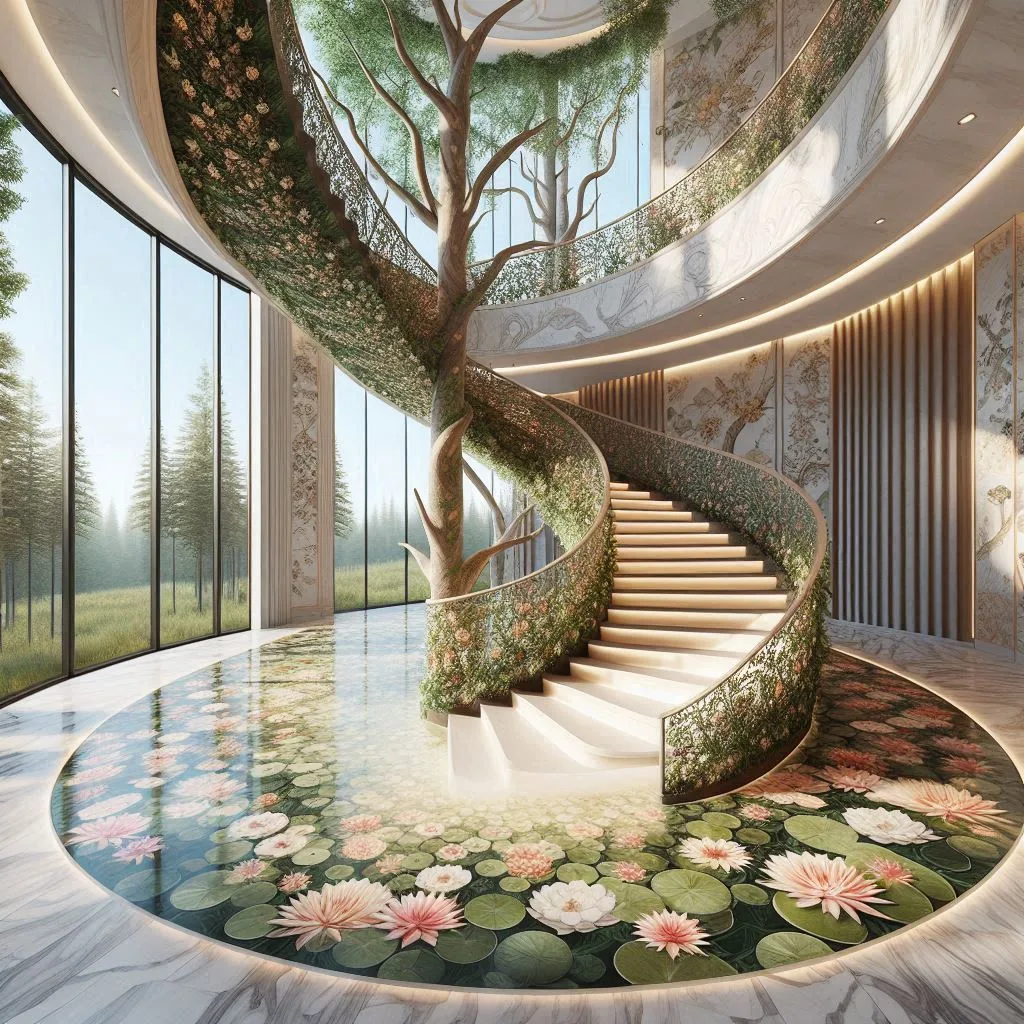
Incorporating nature into your staircase design is not limited to the materials you choose. There are several ways to enhance the overall aesthetic and atmosphere of your staircase by adding natural elements such as plants, natural lighting, and earthy colors.
Add Indoor Plants
Plants are one of the most straightforward ways to create a nature staircase. Adding greenery to your staircase can infuse the space with life and color. Hanging planters along the railings, potted plants at the base of the stairs, or climbing vines cascading up the banister are all great ways to introduce plant life.
Popular Plants for Staircases:
- Pothos: A hardy plant that thrives in indirect light and can cascade beautifully along a railing.
- Ferns: Perfect for adding texture and a lush, green feel.
- Snake Plant: An easy-to-care-for plant that can stand tall and add structure to your staircase.
Maximize Natural Light
One of the best ways to enhance the feeling of being connected to nature is by incorporating plenty of natural light into your staircase design. If possible, design your staircase near windows or glass doors to let in natural sunlight. Skylights are another great option for staircases, especially if your home has multiple stories.
Benefits of Natural Light in Your Staircase:
- Creates an Open Feel: Brightens the space and makes it feel more expansive.
- Improves Mood: Natural light is known to boost mental well-being.
- Energy Efficiency: Reduces the need for artificial lighting during the day.
Earthy Color Palette
The colors you choose for your nature staircase should reflect the natural world. Earth tones such as browns, greens, and grays work well to create a grounded, calming atmosphere. Consider painting the walls surrounding your staircase in soft shades of beige or green to complement the natural materials used in the stairs.
Color Ideas for a Nature Staircase:
- Wood Tones: From light ash to deep walnut, wooden tones are the perfect base for a nature-inspired design.
- Earthy Greens: Olive, sage, and forest green can help to create a serene, calming atmosphere.
- Neutral Grays: Soft gray walls provide a balanced, neutral backdrop for nature-inspired decor.
Eco-Friendly Materials for Nature Staircases
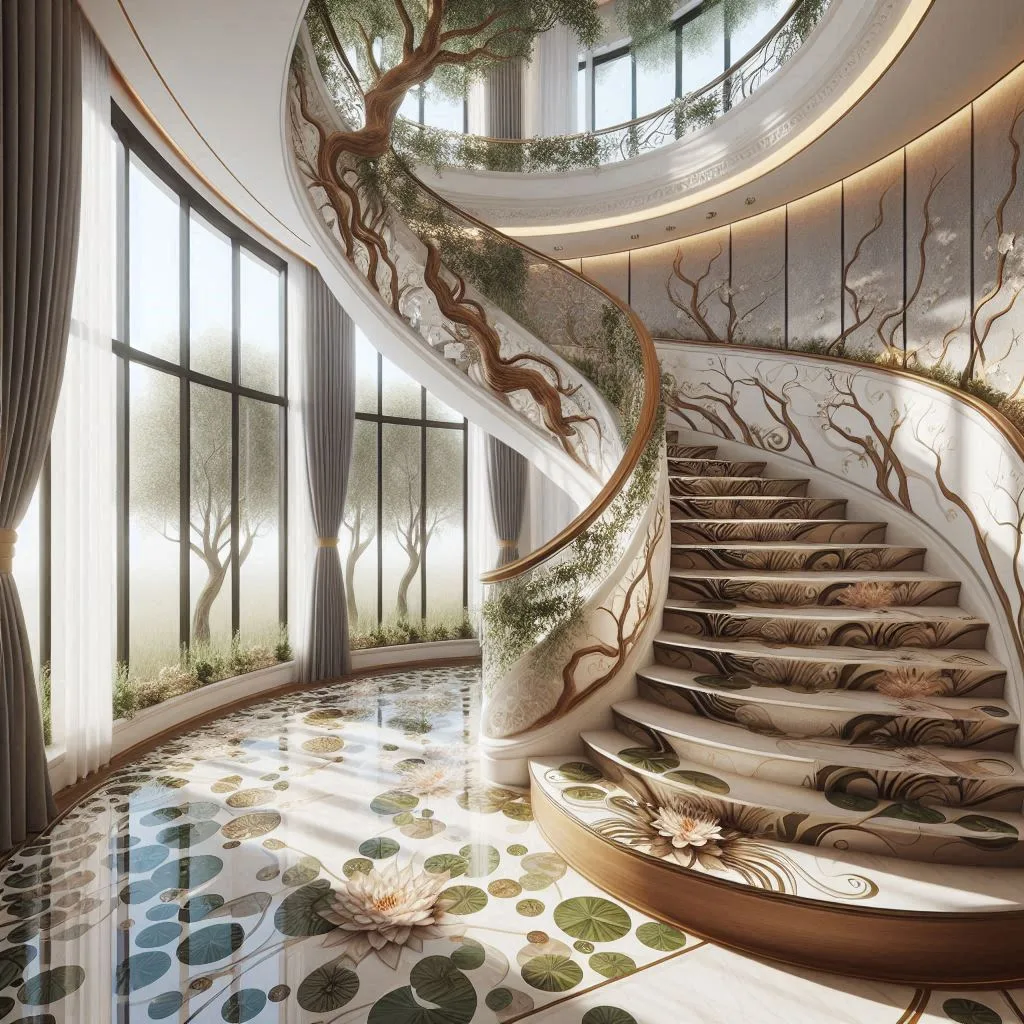
A nature staircase isn’t just about aesthetics; it’s also an opportunity to use sustainable materials that are kind to the environment. Many modern staircases now feature eco-friendly materials that offer the beauty of nature without compromising the planet.
Reclaimed Wood
Using reclaimed wood for your staircase design is an excellent way to make an environmentally conscious choice. Reclaimed wood comes from old barns, warehouses, or other structures and is often repurposed to create stunning, one-of-a-kind staircases. Not only does this help reduce waste, but reclaimed wood also has a unique charm and character that fresh-cut lumber simply cannot replicate.
Bamboo
Bamboo is a fast-growing, sustainable material that is becoming increasingly popular in modern design. Bamboo is incredibly durable and can be used for both stair treads and railings. It’s an excellent choice for those who want a naturally beautiful staircase that’s also environmentally friendly.
Recycled Glass
For a more modern twist, consider using recycled glass for your staircase’s railings or treads. Recycled glass is a highly sustainable material that adds a sleek, contemporary touch to a nature staircase. Plus, it’s durable, easy to maintain, and comes in a variety of colors and textures.
Design Tips for Customizing Your Nature Staircase
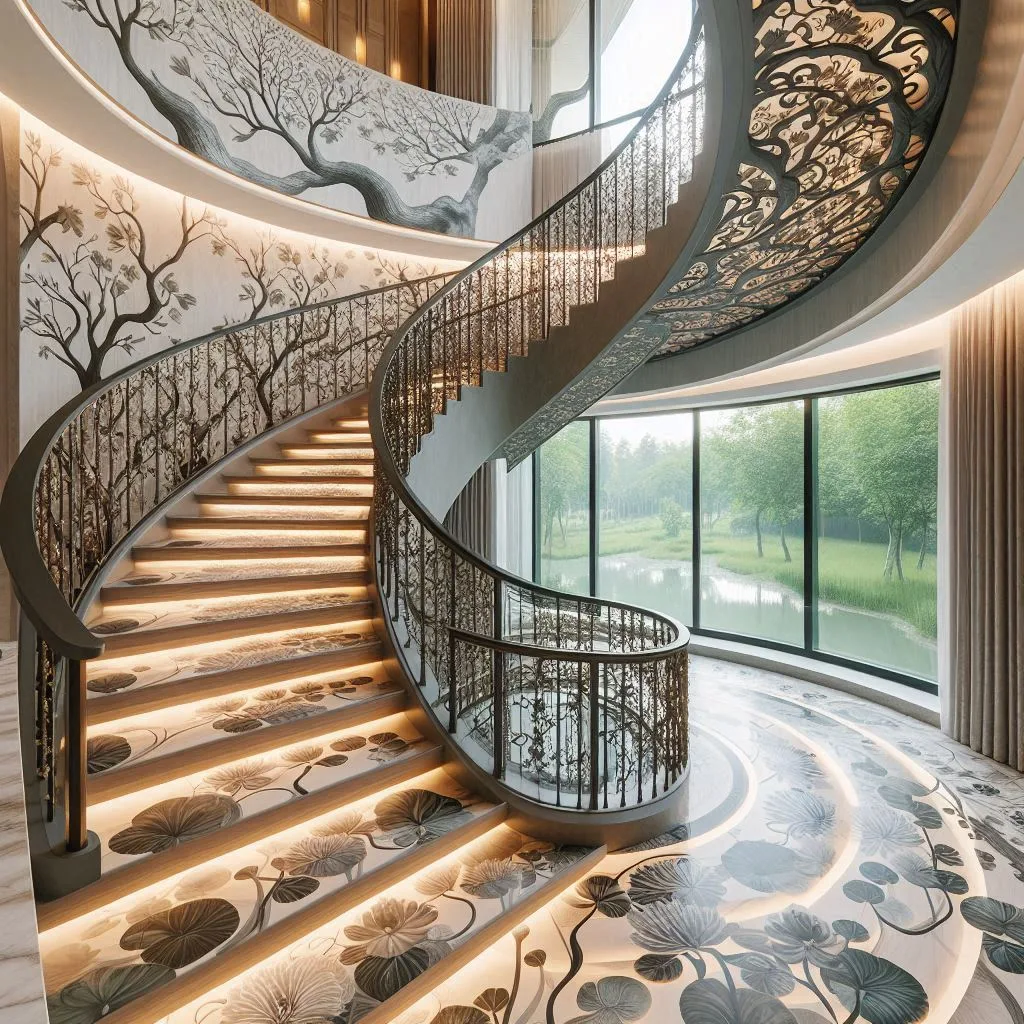
If you’re looking to personalize your nature staircase, there are a few tips and tricks that can help you create a truly unique and harmonious space. Here are some ideas to further customize your staircase and bring more natural elements into your home.
Incorporate Textural Contrast
Textures play an essential role in the appeal of a nature staircase. Combining different textures creates depth and interest in the design. For example, you could pair the smoothness of polished stone treads with a rough-hewn wooden handrail. Alternatively, contrast sleek metal railings with plush, natural wool carpeting on the stairs. These textural combinations will add a tactile dimension to your staircase that enhances its natural charm.
Textural Pairing Ideas:
- Wood and Stone: A combination of wooden steps and stone risers creates a natural yet polished look.
- Leather and Wood: Leather-wrapped handrails with wooden steps provide a luxurious and rustic contrast.
- Stone and Plants: Stone stair treads complemented by creeping ivy or other climbing plants along the walls can bring the staircase to life.
Embrace Minimalist Detailing
Sometimes, less is more. For those who prefer a more minimalist look, a nature staircase can still evoke the outdoors without being overly ornate. Simple wooden steps, clear glass railings, and subtle touches of greenery can maintain the natural aesthetic while keeping the design clean and unencumbered. Minimalist designs often allow the natural beauty of the materials to take center stage, creating a calming and understated atmosphere.
How to Keep it Minimal:
- Opt for clean-lined, straight staircases instead of intricate, curved designs.
- Choose a neutral color palette that lets the natural materials shine.
- Limit the use of embellishments or additional decor so the design feels simple yet sophisticated.
Enhance with Natural Lighting
Natural light has an undeniable connection to the outdoors, making it a crucial element for any nature staircase. To maximize natural light, consider the direction of your staircase in relation to the sun’s path. Staircases located near windows or skylights will benefit the most from the natural light flowing through. Additionally, large glass windows or open spaces at the landing can allow sunlight to filter down the staircase, creating a light-filled and airy environment.
Creative Lighting Solutions:
- Skylights: These can illuminate your staircase, especially if it’s located on an upper floor or has a landing in between.
- Glass Walls: Consider adding large glass panels along the staircase or adjacent walls to flood the area with natural light.
- Transom Windows: Installing small transom windows above your stairway can allow light to cascade down without compromising privacy.
Experiment with Green Walls
For a truly stunning and bold statement, consider creating a green wall or vertical garden along the staircase. These living walls can be made up of a variety of plants, creating an indoor garden that turns your staircase into a vibrant, dynamic feature. Green walls can bring a touch of the outdoors inside, offering the benefits of increased oxygen levels and improved air quality, while also adding a lush, natural texture to your home.
Steps to Create a Green Wall:
- Choose plants that thrive in indoor conditions, such as ferns, moss, or ivy.
- Install a vertical garden system or use a DIY solution with planters mounted on the wall.
- Ensure there is adequate sunlight or consider using artificial grow lights to support the plants’ growth.
Why Choose a Nature Staircase for Your Home?
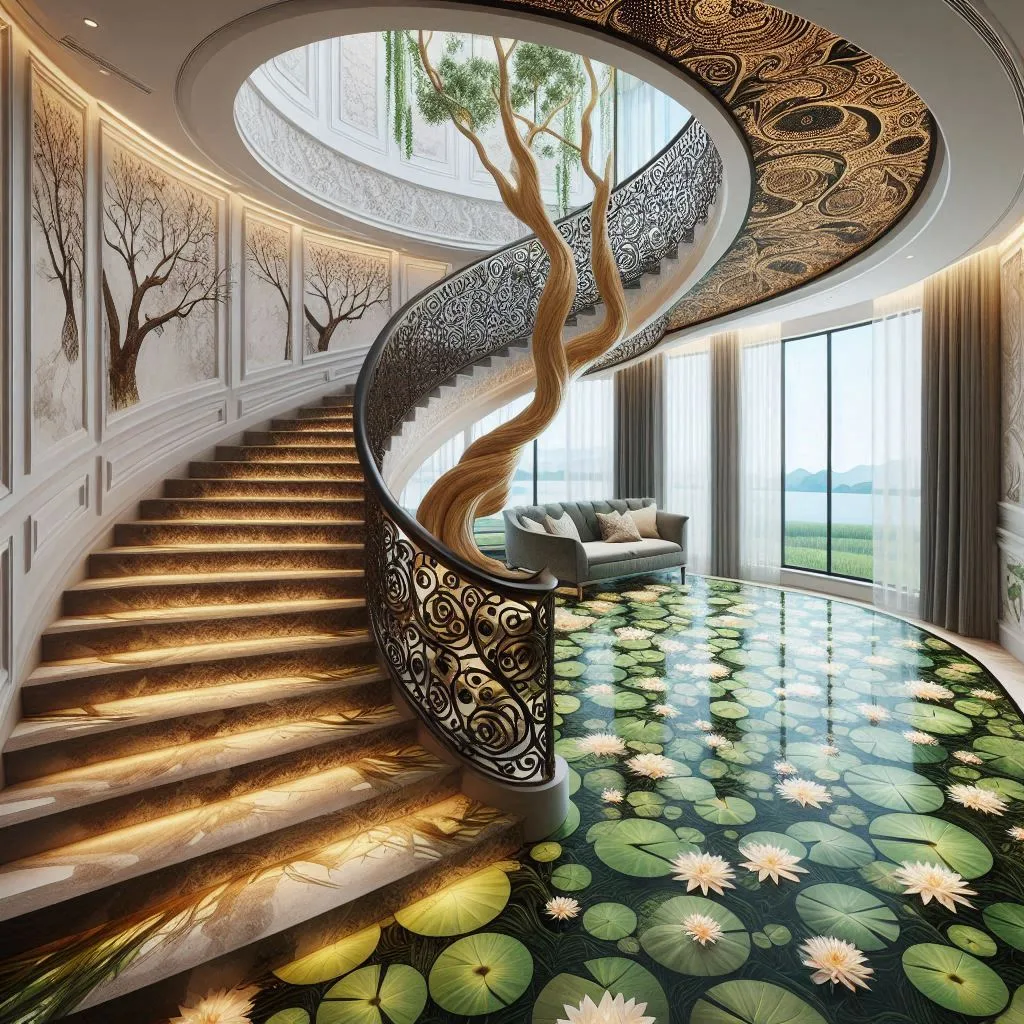
Connection to the Environment
A nature staircase fosters a deeper connection to the environment, both by incorporating natural elements into your living space and by helping you feel more grounded. In an increasingly urbanized world, having natural elements within your home can create a peaceful sanctuary where you can unwind and find serenity. As nature-inspired designs continue to dominate, people are looking for ways to bring elements of the outdoors into their indoor living spaces.
Health Benefits of Nature-Inspired Design
Studies have shown that spending time in nature has a multitude of mental and physical health benefits, from reducing stress levels to enhancing cognitive function. By designing your staircase with natural materials, plants, and light, you can create an environment that fosters well-being. The calming presence of wood, stone, and greenery can have a positive impact on your mood, making your home feel more relaxing and inviting.
Sustainability and Eco-Conscious Living
Incorporating eco-friendly materials in your staircase design reflects a growing commitment to sustainable living. Whether you’re opting for reclaimed wood, bamboo, or stone, these materials are not only beautiful but also better for the planet. By investing in long-lasting, renewable materials, you can reduce your carbon footprint and create a staircase that aligns with your eco-conscious values.
Increase the Value of Your Home
A well-designed nature staircase can elevate the overall aesthetic of your home, making it a stunning focal point that attracts attention and admiration. Whether you’re planning to stay in your home for years to come or you’re thinking about selling in the future, a beautifully designed staircase can increase the resale value of your property. Potential buyers often look for homes with unique, quality features, and a nature staircase is an investment that could pay off in the long run.
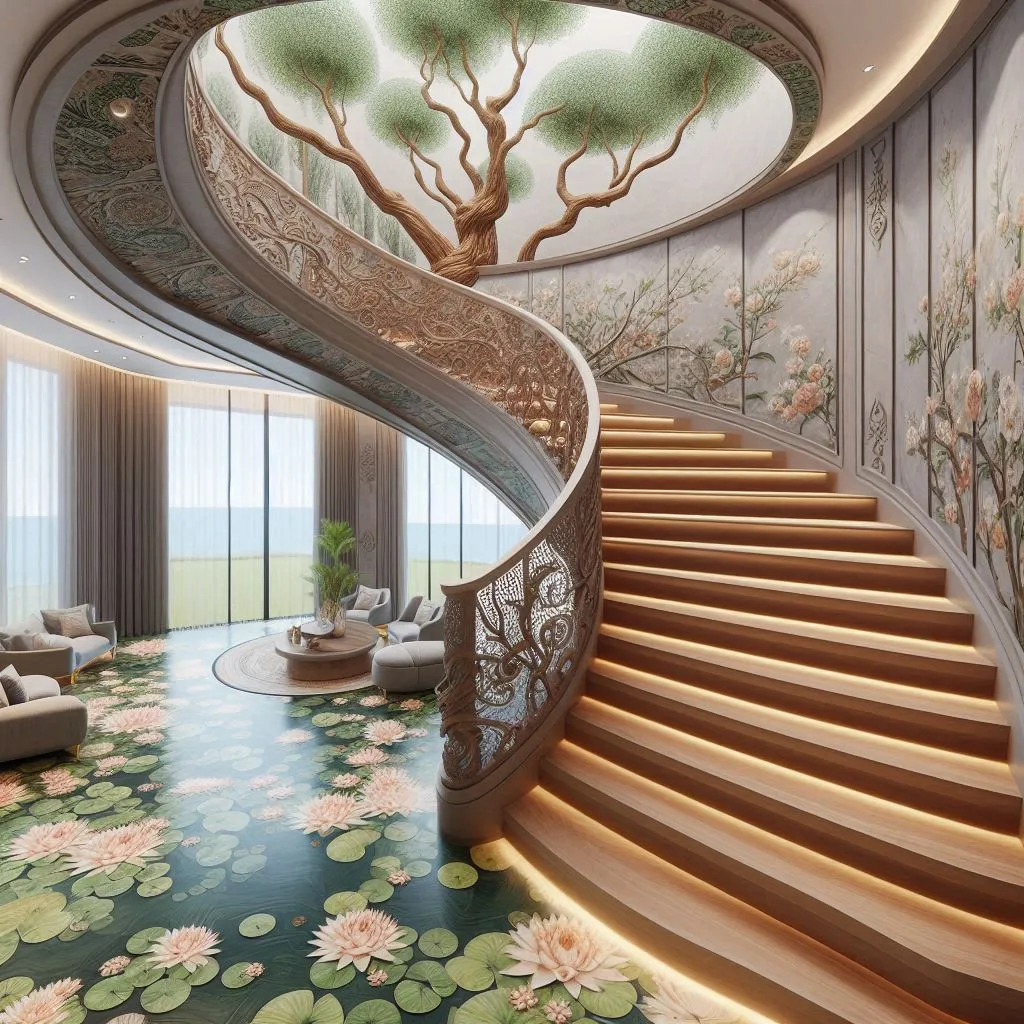
Conclusion: A Nature Staircase is More Than Just a Trend
A nature staircase is more than just a design trend—it’s an embodiment of our desire to reconnect with the natural world. Whether you prefer the rustic appeal of wooden treads, the timeless elegance of stone, or the modern touch of glass and steel, incorporating natural materials into your staircase can completely transform the feel of your home.
By thoughtfully selecting eco-friendly materials, adding plants, and maximizing natural light, you can create a space that blends the beauty of nature with the functionality of everyday life. The nature staircase isn’t just an aesthetic choice; it’s a step toward sustainable, health-conscious living that brings a sense of calm and balance to your environment.
So, whether you’re building a new home or renovating an existing space, consider embracing the natural beauty and elegance of a nature staircase—and let the outdoors become an integral part of your indoor life.

